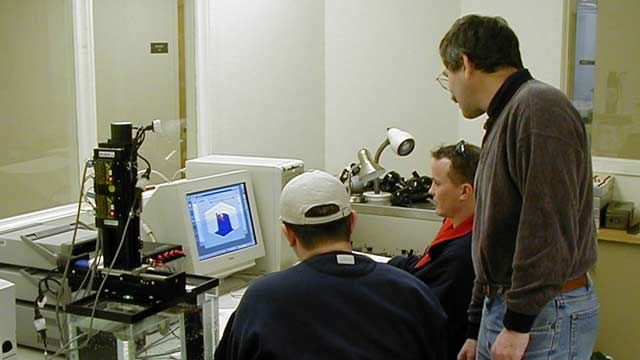Northeastern University’s High-Tech Tools and Toys Lab Teaches Freshmen to Think Like Engineers
“We chose MATLAB as the programming environment for interfacing computers with test and measurement instrumentation because it enables professors to introduce programming and engineering concepts in simple, easily observable, sequential steps.”
Challenge
Solution
Results
- Real engineering experience
- A single, efficient software environment
- Positive student feedback

Faculty at the High-Tech Tools and Toys Laboratory (HTT&TL) at Northeastern University teach programming and engineering concepts to freshmen through hands-on experience with test and measurement instrumentation. Created by Professors Stephen McKnight and Gilead Tadmor of Northeastern University and Professor E. Carr Everback of Swarthmore College, the lab uses MATLAB®, Data Acquisition Toolbox™, and Instrument Control Toolbox™ as the platform for conducting experiments and analyzing results. The lab is the foundation for the required freshman engineering course Engineering Problem-Solving and Computation.
“The lab offers an excellent introduction to programming concepts that are often troublesome for the beginner,” comments McKnight. “By using MATLAB as the programming environment and providing opportunities for hands-on learning, we are enhancing the students’ ability to succeed.”
Challenge
Freshmen enter the engineering program with diverse abilities and interests. While some have designed their own Web sites and completed courses in C or C++, others barely understand directory structures and file manipulation.
Creating classroom projects that meet all students’ needs is difficult. Instructors often select easy-to-learn but uninspiring problems, such as number sorting, or examples, such as fluid friction, that depend on advanced theories of mathematics and physics. This approach results in lessons that are too hard for beginners or too easy for more advanced students.
McKnight, Tadmor, and Everbach sought to develop a course that would motivate and challenge students whatever their background and experience.
Solution
The professors developed an engineering lab that uses computers interfaced with test and measurement instrumentation to build systems that mimic commercial subsystems, such as global positioning system sensors, ground penetration radar, and digital cameras.
They realized that the lab would be an invaluable teaching tool for exposing students to real engineering challenges. The lab workstations are equipped with General Purpose Interface Bus (GPIB)–capable test and measurement equipment, acoustic and ultrasonic transducers, and stepper motor–controlled actuators. The instrumentation consists of an Agilent® programmable multimeter, power supply, function generator and digital oscilloscope linked to a GPIB controller card, and a PC with a National Instruments I/O board.
MATLAB was chosen as the programming environment because it is a standard. “It is great for problem solving and very useful for visualizations and plotting,” says McKnight. “MATLAB is also easy for the students to work with—they don’t have to program to use it. Finally, it is superior to C for most analysis tasks.”
Data Acquisition Toolbox controls and communicates with industry-standard A/D and D/A boards, and Instrument Control Toolbox enables instrument control commands to be sent over a GPIB, serial, USB, or Ethernet connection. “The overriding advantage of using MathWorks products,” notes McKnight, “is that students can perform instrument control and data acquisition functions in the same environment and with the same syntax they use for signal processing, computation, graphics, and visualization.”
The course curriculum is based on modules that build on each other throughout the semester. Students measure the speed of sound in air and water, control a stepper motor and an x-y positioner, and image a subsurface object by ultrasound reflection. They begin by writing programs that instruct the computer to cause physical movement of a motor—providing immediate, rewarding feedback.
A second project is color-analyzing a videocam image to sort colored Ping-Pong balls into tubes that are rotated into place with a stepper motor.
Between 50 and 100 freshman engineering students take the Engineering Problem-Solving and Computation course in the HTT&TL format each year. As they progress in their studies, they continue to develop and use MathWorks skills in other courses such as Electromagnetic Fields, a junior-year engineering course where students use stepper motors and MATLAB—applying the same skills learned in the HTT&TL curriculum—to control the angle of antennas.
Three Massachusetts community colleges are adopting Northeastern’s lab curriculum into their own engineering courses.
Results
Real engineering experience. “Students experience real-world laboratory effects, such as noise, sampling artifacts, and thresholding techniques,” says McKnight. “They practice reconciling real data with theory and inferring simple mathematical models from measurement data. And they are asked to think like engineers by making realistic tradeoffs between experimental accuracy and measurement time.”
A single, efficient software environment. Students use a single software environment to control the instruments used in their experiments and to analyze data. This avoids the multistep process of saving results to a file and then reading the file into MATLAB for analysis.
Positive student feedback. Feedback from students in the course has been overwhelmingly positive. Weston Ford, a mechanical engineering major who took the course, says, “I like using MATLAB along with the lab hardware to show how our experiments are related to real-world problems and to our majors. The two big advantages of using MATLAB are that it’s powerful and it’s easy to learn.”
Acknowledgements
Northeastern University is among the 1300 universities worldwide that provide campus-wide access to MATLAB and Simulink. With the Campus-Wide License, researchers, faculty, and students have access to a common configuration of products, at the latest release level, for use anywhere—in the classroom, at home, in the lab or in the field.